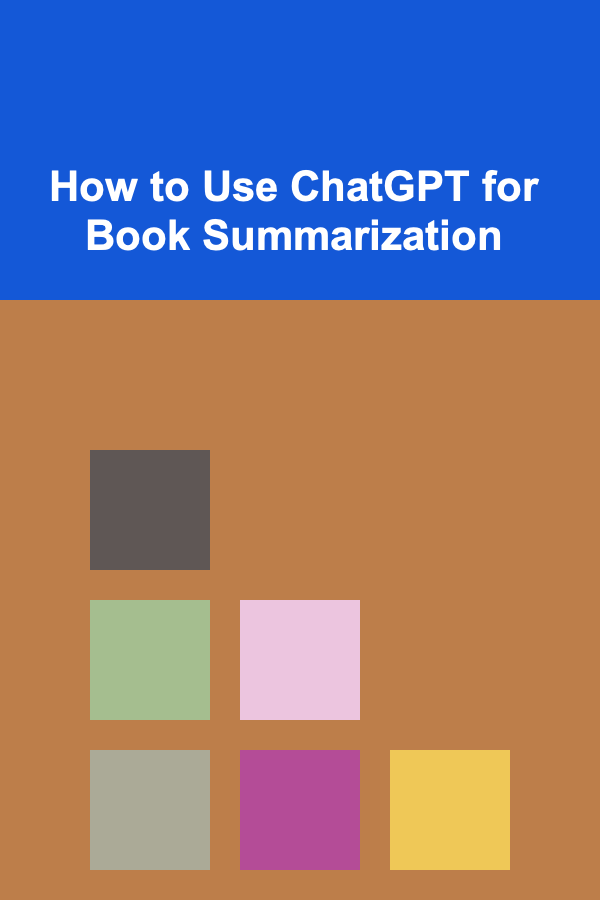
How to Use ChatGPT for Book Summarization
ebook include PDF & Audio bundle (Micro Guide)
$12.99$10.99
Limited Time Offer! Order within the next:

Book summarization is a powerful tool for readers, researchers, and educators who want to condense the vast amount of information found in a book into more digestible portions. Traditionally, summarization requires either manually reading the entire text or using automated tools that lack nuance. However, advancements in AI, particularly language models like ChatGPT, offer new opportunities for efficient and effective summarization. In this article, we will explore how to use ChatGPT for book summarization, providing insights into its strengths, techniques, and potential challenges.
What is Book Summarization?
Book summarization refers to the process of distilling a book's content into a concise form while retaining its essential ideas, themes, and arguments. Summaries provide a quick way to grasp the core messages of a book without reading it in full, which can be especially helpful for academic purposes, business professionals, or anyone pressed for time. Summaries come in various forms:
- Abstract Summary: A brief overview focusing on the central idea and major themes.
- Chapter Summaries: Short descriptions of each chapter, often with key points or events.
- Analytical Summaries: In-depth exploration of a book's structure, characters, and themes, offering a critique alongside a synopsis.
AI models like ChatGPT can be particularly useful for summarizing books because they can handle long texts and focus on relevant information, transforming a lengthy book into a manageable summary.
How ChatGPT Works for Summarization
ChatGPT, based on the GPT-4 architecture, is a language model trained on a vast range of texts and is designed to process and generate human-like text. For summarization tasks, ChatGPT works by reading the content provided (in the form of input text) and generating a condensed version. The model relies on its ability to understand context, recognize important ideas, and condense information into a format that retains the original intent.
There are different ways ChatGPT can be applied to summarization:
- Extractive Summarization: This involves extracting sentences or paragraphs directly from the original text that contain the key information.
- Abstractive Summarization: This method allows the model to generate new sentences that summarize the text, often resulting in more readable and coherent summaries.
- Hybrid Approach: A combination of extractive and abstractive methods can also be used, with the model first extracting key segments of the text and then rewriting them in a more concise form.
For most book summarization tasks, ChatGPT excels at both abstractive and hybrid approaches, offering a flexible tool for producing high-quality summaries.
Preparing the Book for Summarization
Before using ChatGPT to summarize a book, it is important to prepare the content appropriately. Depending on the length and complexity of the book, this step can vary, but here are a few key considerations:
1. Breaking Down the Book into Manageable Sections
Since books are often lengthy, it is helpful to break the text into smaller, more manageable sections. ChatGPT has a character limit for processing input at once (around 4,096 tokens for GPT-4). If the book is longer than this limit, you can divide it into chapters or sections. Summarizing in chunks allows ChatGPT to process the content without losing focus or context.
2. Highlight Key Themes and Concepts
For an effective summary, it's essential to identify the most important themes, ideas, and arguments within the book. If the book is complex, you may want to extract these elements manually before inputting the text into ChatGPT to ensure they are included in the final summary.
3. Decide on the Type of Summary
Depending on your goal, you might need a different type of summary. If you just need a brief overview, a few key points may suffice. If you're looking for an in-depth analysis, you might want to request a more detailed summary with attention to specific themes, characters, or messages. Clarifying this before starting the summarization will help tailor the process to your needs.
Steps to Use ChatGPT for Book Summarization
Now that we've discussed the basics, let's dive into the steps for using ChatGPT to summarize a book effectively.
Step 1: Prepare the Book Text
Start by selecting the part of the book you want to summarize. If it's a long book, divide it into chapters or significant sections. You may even consider giving ChatGPT only one chapter at a time, as this allows it to focus on specific content and provides a more detailed summary.
Step 2: Input the Text into ChatGPT
Input the text of the chapter or section into ChatGPT. If the text is too long, consider breaking it up into multiple prompts, ensuring each prompt stays within the token limit. You can input the text in its entirety or simply provide an excerpt if you're looking for a more focused summary.
You could phrase your prompt like this:
- "Summarize the following text, highlighting the key points and themes: [insert text]."
- "Provide a detailed summary of this chapter, including the main ideas and any significant events: [insert chapter]."
If you want more depth, be specific about what you want from the summary, for example:
- "Summarize this chapter, and focus on the character development of [character name]."
- "Please provide a summary of this section and analyze its impact on the book's central theme."
Step 3: Refine and Review the Summary
Once ChatGPT generates a summary, review it carefully. The model's output can vary depending on the complexity of the text and the clarity of the prompt. If the summary is too brief or lacks important details, you can request that the model expand on certain sections or clarify its response.
For example:
- "Can you expand on the character's motivation in this section?"
- "Could you add more information about the key themes in this chapter?"
ChatGPT's responses can be iterative, meaning you can ask it to refine its summaries in multiple stages to ensure it captures the essence of the text.
Step 4: Organize the Summaries
Once you've summarized each chapter or section, you can organize these summaries into a coherent overall summary. If you're creating a detailed summary, you might also include specific quotes, key ideas, or insights that resonate with the central message of the book.
For a more coherent narrative, you can combine the chapter summaries and create transitions between them to make the summary flow like a narrative itself.
Step 5: Use the Summaries
Now that you have a summary of the book, you can use it for your intended purpose---whether that's a study guide, a quick reference, or an overview for a book review or presentation. Keep in mind that the summary can always be fine-tuned to your specific needs as you work with it.
Advantages of Using ChatGPT for Book Summarization
Using ChatGPT for book summarization comes with several advantages:
1. Speed and Efficiency
One of the most significant advantages of using ChatGPT is speed. Instead of spending hours reading and condensing a book manually, ChatGPT can generate a summary in minutes. This is particularly helpful for professionals or students who need quick overviews of large amounts of text.
2. Customization
ChatGPT allows you to tailor the summaries to your specific needs. Whether you want a high-level summary, a detailed analysis, or a focus on particular characters or themes, ChatGPT can adjust to meet your preferences.
3. Improved Understanding
Sometimes, reading a book can be overwhelming due to its length or complexity. ChatGPT can help clarify difficult concepts or present them in a more digestible form, improving your understanding of the material.
4. Cost-Effective
For those on a budget or those who prefer not to spend on professional summarization services, ChatGPT offers an affordable alternative that delivers high-quality results.
5. Accessibility
ChatGPT is available anytime, anywhere, as long as you have internet access. This makes it an invaluable tool for people with tight schedules or those who need to access book summaries quickly.
Challenges and Limitations
Despite its many advantages, using ChatGPT for book summarization has some limitations and challenges.
1. Loss of Nuance
ChatGPT's summaries can sometimes lack the depth and nuance that a human reader might bring to the task. It might miss subtle themes, tones, or character development, which could be crucial for a complete understanding of the book.
2. Dependence on Input Quality
The quality of the summary depends largely on the quality of the input. If the input text is ambiguous or difficult to parse, the summary may not be as accurate or comprehensive.
3. Difficulty with Complex Texts
Highly complex texts, such as philosophical works or dense academic material, might be challenging for ChatGPT to summarize accurately. While the model is generally good at identifying key ideas, it might struggle with intricate arguments or abstract concepts.
4. Character Limitations
ChatGPT's token limit can restrict its ability to process long books or extensive sections at once. For very long works, you'll need to summarize in chunks, which might break the flow of the text.
Conclusion
ChatGPT provides a powerful and efficient tool for summarizing books, offering readers and professionals an easy way to condense complex texts into manageable summaries. By breaking down a book into sections, preparing the text appropriately, and leveraging the capabilities of ChatGPT, users can produce concise and accurate summaries tailored to their needs. While there are challenges in terms of nuance and complexity, the flexibility and speed that ChatGPT offers make it an invaluable resource for anyone looking to summarize books quickly and effectively. Whether for academic study, personal reading, or professional use, ChatGPT can significantly streamline the summarization process.

10 Simple Tips for Reducing Water Usage at Home
Read More
Corporate Trainer's Handbook: Essential Techniques, Tips, and Best Practices
Read More
How To Develop Your Creativity Through Writing Prompts
Read More
How to Install a Home Security System Without Professional Help
Read More
How to Organize Your Home Bar for Entertaining
Read More
10 Tips for Designing a Visually Appealing Music Listening Planner
Read MoreOther Products

10 Simple Tips for Reducing Water Usage at Home
Read More
Corporate Trainer's Handbook: Essential Techniques, Tips, and Best Practices
Read More
How To Develop Your Creativity Through Writing Prompts
Read More
How to Install a Home Security System Without Professional Help
Read More
How to Organize Your Home Bar for Entertaining
Read More